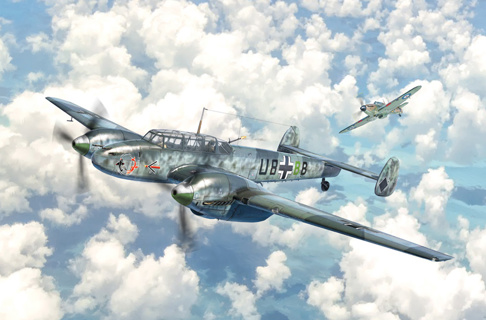Bf-110 C3/C4 Zerstörer RR
Item No. 049
Alongside the Messerschmitt Bf 109 fighter and the Junkers Ju-87 Stuka dive bomber, the Messerschmitt Bf 110 Zerstörer is considered one of the symbols of the Luftwaffe during the Second World War. The Messerschmitt's heavy multirole twin-engine fighter was extensively employed by the German air for
Description
Alongside the Messerschmitt Bf 109 fighter and the Junkers Ju-87 Stuka dive bomber, the Messerschmitt Bf 110 Zerstörer is considered one of the symbols of the Luftwaffe during the Second World War.
The Messerschmitt's heavy multirole twin-engine fighter was extensively employed by the German air force during the war and, in its various versions, used to fulfil several operational roles: interceptor, fighter-bomber, reconnaissance, anti-ship aircraft, and night fighter. Its two Daimler-Benz DB 601 engines, capable of delivering 1200 hp, allowed the heavy fighter to reach a maximum speed of 560 km/h. Versions C and D were widely deployed on all fronts from the early stages of the war.
Heavily armed with two 20mm cannons, four 7.92mm machine guns, and a rear machine gun for self-defence, it could carry bombs or additional fuel tanks under the wings to increase its operational range.
The Messerschmitt's heavy multirole twin-engine fighter was extensively employed by the German air force during the war and, in its various versions, used to fulfil several operational roles: interceptor, fighter-bomber, reconnaissance, anti-ship aircraft, and night fighter. Its two Daimler-Benz DB 601 engines, capable of delivering 1200 hp, allowed the heavy fighter to reach a maximum speed of 560 km/h. Versions C and D were widely deployed on all fronts from the early stages of the war.
Heavily armed with two 20mm cannons, four 7.92mm machine guns, and a rear machine gun for self-defence, it could carry bombs or additional fuel tanks under the wings to increase its operational range.
Bf-110 C3/C4 Zerstörer RR
Item No. 049
Alongside the Messerschmitt Bf 109 fighter and the Junkers Ju-87 Stuka dive bomber, the Messerschmitt Bf 110 Zerstörer is considered one of the symbols of the Luftwaffe during the Second World War. The Messerschmitt's heavy multirole twin-engine fighter was extensively employed by the German air for
Description
Alongside the Messerschmitt Bf 109 fighter and the Junkers Ju-87 Stuka dive bomber, the Messerschmitt Bf 110 Zerstörer is considered one of the symbols of the Luftwaffe during the Second World War.
The Messerschmitt's heavy multirole twin-engine fighter was extensively employed by the German air force during the war and, in its various versions, used to fulfil several operational roles: interceptor, fighter-bomber, reconnaissance, anti-ship aircraft, and night fighter. Its two Daimler-Benz DB 601 engines, capable of delivering 1200 hp, allowed the heavy fighter to reach a maximum speed of 560 km/h. Versions C and D were widely deployed on all fronts from the early stages of the war.
Heavily armed with two 20mm cannons, four 7.92mm machine guns, and a rear machine gun for self-defence, it could carry bombs or additional fuel tanks under the wings to increase its operational range.
The Messerschmitt's heavy multirole twin-engine fighter was extensively employed by the German air force during the war and, in its various versions, used to fulfil several operational roles: interceptor, fighter-bomber, reconnaissance, anti-ship aircraft, and night fighter. Its two Daimler-Benz DB 601 engines, capable of delivering 1200 hp, allowed the heavy fighter to reach a maximum speed of 560 km/h. Versions C and D were widely deployed on all fronts from the early stages of the war.
Heavily armed with two 20mm cannons, four 7.92mm machine guns, and a rear machine gun for self-defence, it could carry bombs or additional fuel tanks under the wings to increase its operational range.

